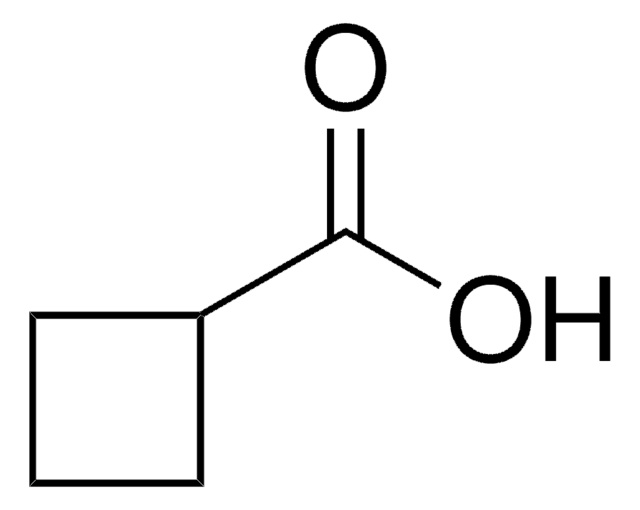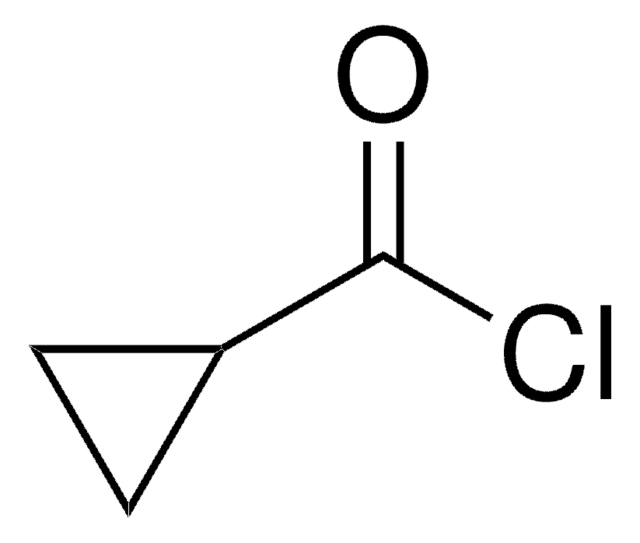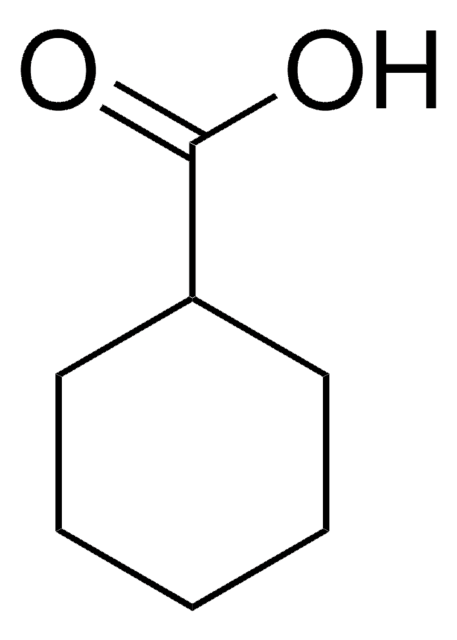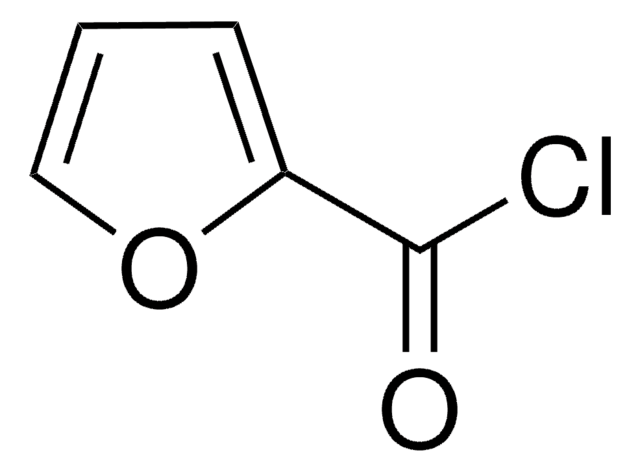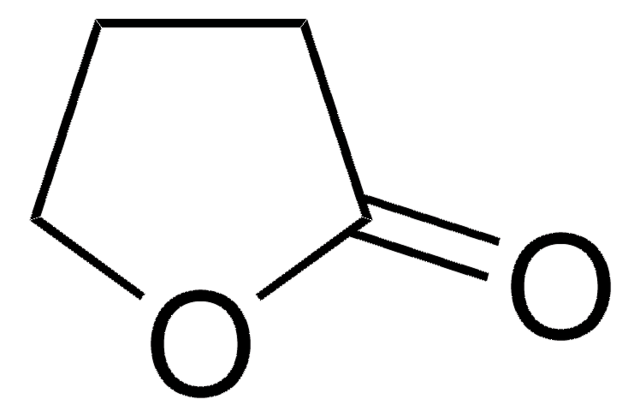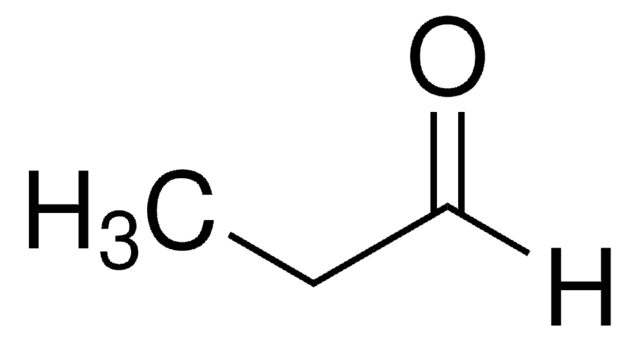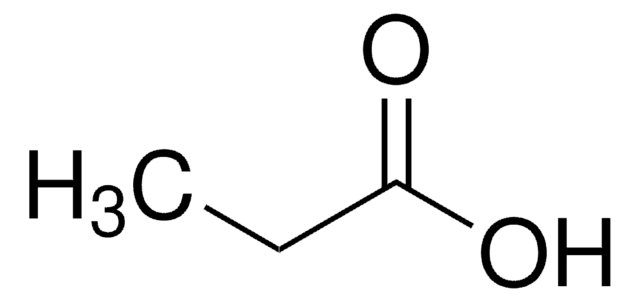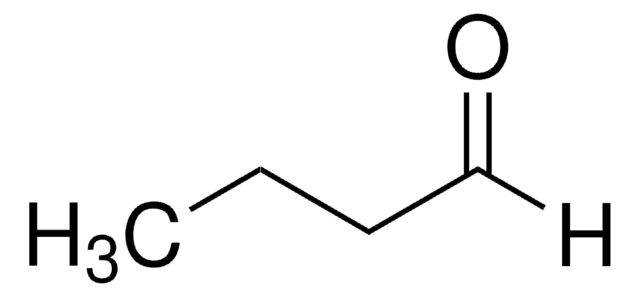C116602
Cyclopropanecarboxylic acid
95%
Synonym(s):
CPC-acid
Sign Into View Organizational & Contract Pricing
All Photos(1)
About This Item
Linear Formula:
C3H5CO2H
CAS Number:
Molecular Weight:
86.09
Beilstein:
969839
EC Number:
MDL number:
UNSPSC Code:
12352100
PubChem Substance ID:
NACRES:
NA.22
Recommended Products
Quality Level
Assay
95%
form
liquid
refractive index
n20/D 1.438 (lit.)
bp
182-184 °C (lit.)
mp
14-17 °C (lit.)
density
1.081 g/mL at 25 °C (lit.)
storage temp.
2-8°C
SMILES string
OC(=O)C1CC1
InChI
1S/C4H6O2/c5-4(6)3-1-2-3/h3H,1-2H2,(H,5,6)
InChI key
YMGUBTXCNDTFJI-UHFFFAOYSA-N
Looking for similar products? Visit Product Comparison Guide
Related Categories
Signal Word
Danger
Hazard Statements
Precautionary Statements
Hazard Classifications
Skin Corr. 1B
Storage Class Code
8A - Combustible corrosive hazardous materials
WGK
WGK 3
Flash Point(F)
161.6 °F - closed cup
Flash Point(C)
72 °C - closed cup
Personal Protective Equipment
dust mask type N95 (US), Eyeshields, Gloves
Choose from one of the most recent versions:
Already Own This Product?
Find documentation for the products that you have recently purchased in the Document Library.
Perali Ramu Sridhar et al.
Chemical communications (Cambridge, England), 48(5), 756-758 (2011-12-03)
A stereoselective methodology was developed for the construction of C-spiro-glycosides in two steps involving bromonium ion activated solvolytic ring opening of sugar derived 1,2-cyclopropanecarboxylates followed by a one-pot dehydrohalogenation, intramolecular hetero-Michael addition (IHMA) and ester hydrolysis. The obtained spirocyclic lactols
F X Sureda et al.
Neuroreport, 7(11), 1824-1828 (1996-07-29)
The effect of 1-aminocyclopropanecarboxylic acid (ACPC) on the potentiation by glycine of N-methyl-D-aspartate (NMDA)-evoked increases in intracellular free calcium concentration [Ca2+]i was examined in cultured rat cerebellar granule cells. NMDA (50 microM) produced a rapid and sustained increase in [Ca2+]i
Tetsuo Toraya et al.
Applied and environmental microbiology, 70(1), 224-228 (2004-01-09)
A new strain isolated from soil utilizes cyclopropanecarboxylate as the sole source of carbon and energy and was identified as Rhodococcus rhodochrous (H. Nishihara, Y. Ochi, H. Nakano, M. Ando, and T. Toraya, J. Ferment. Bioeng. 80:400-402, 1995). A novel
H M Badawi et al.
Spectrochimica acta. Part A, Molecular and biomolecular spectroscopy, 71(4), 1540-1546 (2008-07-05)
The structural stability and internal rotations in cyclopropanecarboxylic acid and cyclopropanecarboxamide were investigated by the DFT-B3LYP and the ab initio MP2 calculations using 6-311G** and 6-311+G** basis sets. The computations were extended to the MP4//MP2/6-311G** and CCSD(T)//MP2/6-311G** single-point calculations. From
D B Buxton et al.
Metabolism: clinical and experimental, 32(7), 736-744 (1983-07-01)
The effects of the hypoglycemic agent, cyclopropane carboxylate, on the metabolism of various substrates that enter the mitochondrion via the mitochondrial monocarboxylate transporter were investigated in perfused rat livers. Metabolism of pyruvate, branched-chain alpha-keto acids, acetoacetate and, to a lesser
Our team of scientists has experience in all areas of research including Life Science, Material Science, Chemical Synthesis, Chromatography, Analytical and many others.
Contact Technical Service